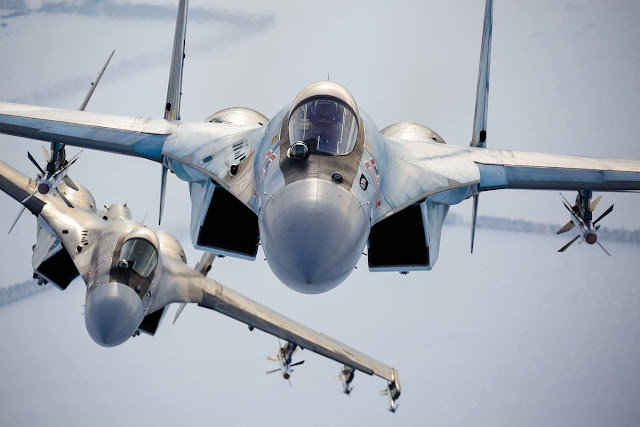Su-35 - Image: Минобороны России
Russia Fears Losing Ground to the PRC in World Arms Market
by Reuben F. Johnson
The recent release of the latest Stockholm International Peace Research Institute (SIPRI) report on the worldwide trade in weapon systems has observers in Moscow asking unhappy questions. Their chief concern is that gains made in 2012-2017 by the People’s Republic of China (PRC) in different regions are ultimately at the expense of sales that might otherwise have been made by Russian suppliers.
The issue was addressed in the last week of March by the editors of the Russian-language Nezavisimoye Voyennoe Obozreniye (NVO), one of the nation’s most authoritative defense periodicals. The PRC’s previous market share has been small, the editors write, and the nation has been more along the lines of a large-scale importer of weapons—particularly those from Russian manufacturers.
What has become the cause for worry, says the publication, is that “in a short historical period of time, Beijing has made a sharp turn upwards and has broken into the ranks of the top five leading exporters—turning the process of military-technical cooperation with foreign nations into an effective instrument of political and economic influence.”
The PRC, the report notes, has made considerable investments in its defense industrial base. The increase in the number of arms exports has been accompanied by a commensurate improvement in the overall qualitative and technological ranking of the PRC’s weapon systems. This telegraphs the “serious objectives of the military and political leadership of the PRC to transform the country into a world-class power in all respects.”
The PRC has had its traditional customers over the years, some of which were left to the Chinese, as they were nations that Russia found it inconvenient to cultivate as clients. The most prevalent of them is Pakistan. Sales by Moscow to Islamabad would undoubtedly damage relations with India, one of the longest-running and most profitable relationships for sale of Russian military hardware.
However, what has driven the PRC’s success in foreign sales is not Pakistan, but rather markets where Beijing is positioned to displace Russia as the main source of weaponry. Two developments mentioned in the NVO commentary were the recent sale of air defense systems to Turkmenistan, a former Soviet republic, and the announced intention in 2013 by Turkey to purchase an export version of the PRC’s CASIC HQ-9, which is designated FD-2000 in the export configuration. The PRC is also blamed for “blocking efforts by Russia to make significant inroads into selling military hardware to Indonesia.”
The decision by the Turks to purchase a Chinese-made air defense system has been a sore point with Russian industry because the HQ-9 is a reverse-engineered copy of the Russian-made Almaz-Antei S-300. Furthermore, the follow-on model to the S-300 from Almaz-Antei, the S-400 system, was one of the other competing options presented to the Turks in the tender. Ultimately, the Turkish decision was overturned and they did not carry through with the procurement, buying the S-400 instead, but more than one Russian commentator has singled out this particular incident as a harbinger of future events.
Russian defense industry analysts who spoke to AIN point out that Moscow may well be incapable of escaping this future, as Russia continues to sell some of its most advanced weaponry to the PRC. These are, most notably, the Sukhoi Su-35 Super-Flanker and the same S-400 air defense system that has been offered to other potential export customers.
“The lure of making money has consistently overridden national security concerns and just plain common sense when it comes to selling our defense technology to the PRC,” said one aerospace industry specialist in Moscow. “No one learned their lesson apparently when the Chinese spent the 1990s copying the Su-27. They then reneged on the 1996 contract to build 200 Su-27s under license—as well as their obligation to pay the license fee per aircraft to the OEM—after having built slightly more than half of the 200 Su-27s they had signed for. There is now every reason to believe that history will repeat itself with the Su-35.”
Others point to the PRC’s aircraft carrier program, almost all of which is based on Soviet/Russian or Ukrainian-developed design know-how. The PLAN’s sole operational carrier, the Type 001 CV-16 Liaoning, was originally built in the USSR as the Varyag, the sister ship to the Russian Navy’s only carrier, the Admiral Kuznetsov. The ship, later purchased by Beijing from the now-independent nation of Ukraine, was refitted in the PLAN’s Dalian shipyards and then was copied to became the basis for the Type 001A CV-17 Shandong, a near copy of the Ukrainian original.
The Liaoning also operates the Shenyang J-15 carrier-capable fighter, itself a copy of the Sukhoi Su-33 that is flown off Kuznetsov. Another example in a consistent pattern of either cloning Russian hardware one-to-one or making close-copies that are then embellished with “Chinese characteristics."
“Chinese weapon systems are going to continue to improve,” said the aerospace specialist. “Those who are worried about their chances of pushing Russia out of one arms market after another are not worrying for nothing.”
Original post: ainonline.com
The World's Arms Exports
by Dyfed Loesche,
Feb 20, 2017
The volume of international transfers of major weapons in 2012 to 2016 was 8.4 per cent higher than in 2007 to 2011, according to the SIPRI Arms Transfers Database. This was the highest volume for any five-year period since 1990. The total for 2016 stood at $ 31 billion. The biggest exporters by far are the United States and Russia.
Source: statista.com
More info at SIPRI Arms Transfers Database
Sukhoi Su-33: Details
Shenyang J-15: Details
Sukhoi Su-35: Details


No comments:
Post a Comment